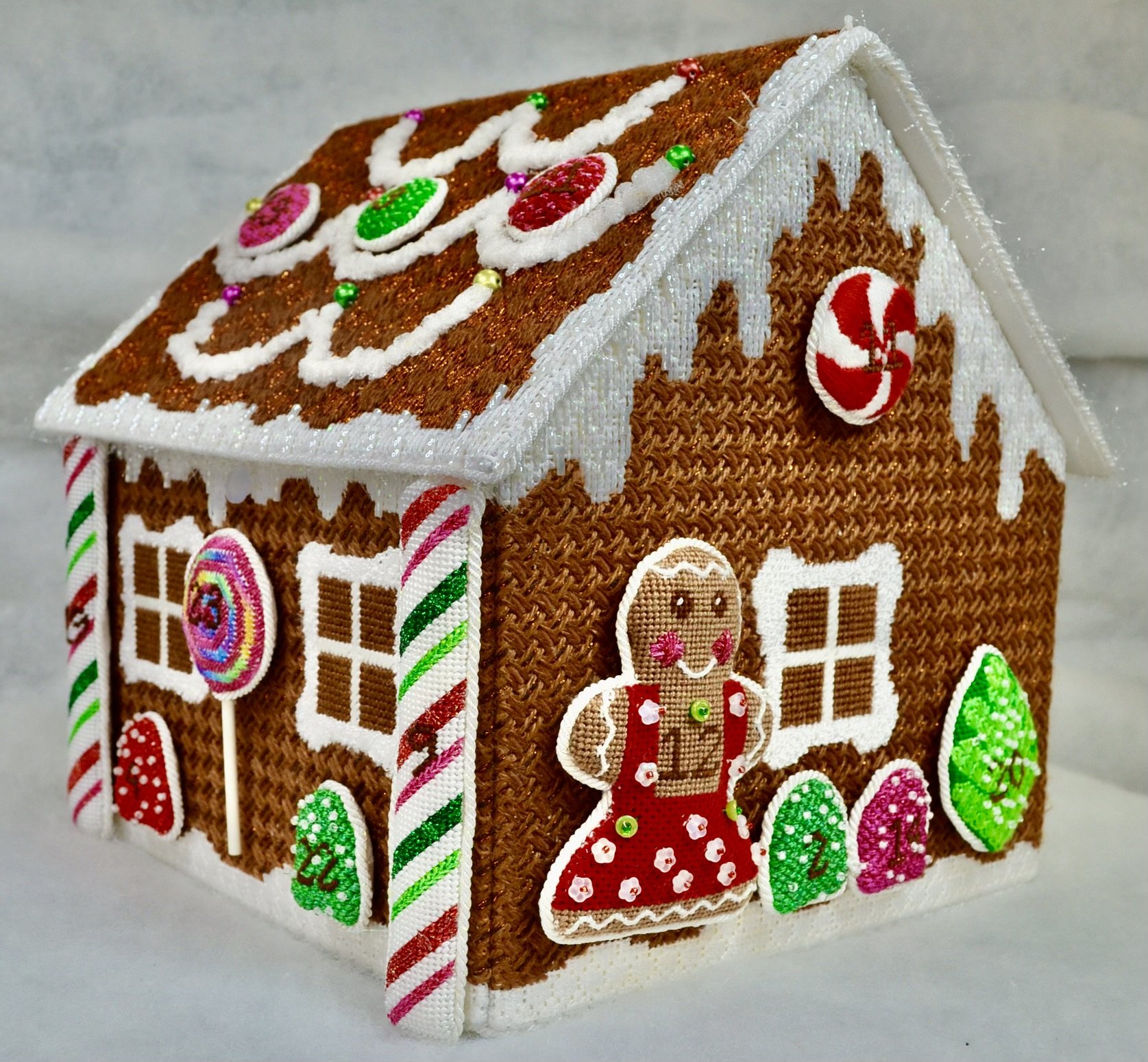After the frenzy of the holidays, I always welcome the slower pace of the first quarter of every year. After seeing today’s stitched sample, I’m ready for the holidays to be here…now.
The stitch is an adorable roof on a gingerbread house that also serves as an advent calendar. (What? How cool! More on that in a minute.) The stitch is offset and alternating scallops over four rows. Super easy and absolutely adorable. Marci used Silk ‘n Ivory (black lines) and Silk Lame 18 (yellow lines). Technically, this scallop stitch is similar to most of my scallop stitches as it follows a single horizontal path. However, Marci was quite clever in changing the threads for every other scallop. (If you look long enough, you should see what I’m talking about.)
Beginning in June, The Nimble Needle in Atlanta is hosting a 10-month club with this Rachel Donley gingerbread house/advent calendar.
It’s charming and filled with fun stitches and techniques for the house and all of the advent calendar dates. Oh, and did I mention it has year-round storage? I wish all Container Store holiday storage was this cute.
You’ll receive canvases, threads, and guides each month. If interested, give the Nimble Needle a call at 404-843-8687.
Back to the stitch.
I am looking forward to using it for water with two different hues of blue or turquoise Kreinik. I also have it in mind for a young lady’s skirt with Vineyard Silk (black lines) and Flair (Just a reminder about how to evaluate stitches for size on your project. Clearly, it’s a fantastic roof. You could use two shade of Straw Silk for a roof on a country house. For even more whimsical houses, you may want to consider adding a third color, such as pink, yellow, and white for an Easter house. A lot of fun is to be had with this stitch.
As you are auditioning stitches (from any stitch source), count the number of canvas threads on the diagram that match your mesh size. And there you have what an inch of the stitch will look like. Evaluate that against the area where you plan to use the stitch and make your final decision. If you start integrating this step into your stitch selection process, you may be surprised at how many stitches you think are large are much smaller than you realize. (Or, in today’s case, the stitch is much larger than it looks.)
By (sometimes) including this step in my own process, I find I am now integrating much longer stitches than I ever thought I would. I used to think a stitch six rows long was super big. I have very much changed my tune, which has helped me expand my creativity, especially for large-space stitches.
Today’s stitch diagram, along with all other #whimsicalwednesday and #smallspacesunday stitch diagrams, can also be found on a Pinterest board here. Be sure to follow whimsicalstitch.com on Facebook, Pinterest, Instagram, and Twitter.
If you like what you see on this blog, there's more. Mary’s Whimsical Stitches is a series of three books offering contemporary how-to collections of more than 250 stitches (in each volume) for all stitchers, regardless of skill level. All books include updated and sequenced diagrams from this blog plus a collection of all-new stitches from private lessons and other class projects. Visit here to find a needlepoint retailer that carries my books.
New to needlepoint or looking for a refresher? Please download a handy how-to guide covering basic needlepoint stitches and stitch compensation techniques along with new top-line information on needlepoint materials and tools, how to handle threads, and other helpful needlepoint resources.
whimsicalstitch.com also sells Stitch Guides and Stitch Concepts for Melissa Shirley Designs, Zecca Designs, Sandra Gilmore, Purple Palm, Maggie, and Penny MacLeod, and many more. Click here to see the newest guides and click here to see the entire collection.
I hope you have the perfect spot for this stitch! Please enjoy! Have a wonderful #whimsicalwednesday!
A Note about Diagrams
I use color in diagrams to make them as clear as possible. The primary function of different colored lines is to illustrate a stitch sequence. For example, the layering of colors demonstrates you add them in that order. They can also provide ideas on integrating additional threads (one line for each color). Or, you can use the same thread for all color lines. That's where I encourage you to use your imagination for the space you are stitching!







